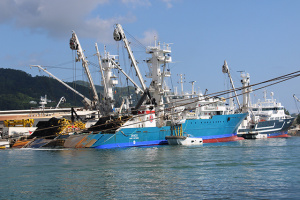Seychelles-flagged purse seiners get increase in yellowfin tuna catch to 35,800 tonnes
Fisheries |Author: Salifa Karapetyan Edited by: Betymie Bonnelame | June 14, 2021, Monday @ 14:07| 12652 views
The change in allocation for Seychelles and other countries follows the 25th meeting session of the IOTC that took place June 7-11. (Rassin Vannier)
(Seychelles News Agency) - Seychelles-flagged purse seiners now have a yellowfin tuna catch allocation of 35,800 tonnes, as the Indian Ocean Tuna Commission's (IOTC) relooks at the allocation mechanism for the species through adopting a new resolution to be effective next year.
The allocation of yellowfin for Seychelles' purse seiner fleet was 33,211 metric tonnes for the year which was equally divided among the 13 vessels flying the flag of the island nation in the western Indian Ocean.
The change in allocation for Seychelles and other countries follows the 25th meeting session of the IOTC that took place June 7-11.
In 2015, the IOTC's scientific committee established that the Indian Ocean yellowfin tuna stock is being overfished. Consequently, Resolution 16/01 adopted an "Interim plan for rebuilding the Indian Ocean yellowfin tuna stock in the IOTC area of competence." The Resolution was revised in 2017, 2018 and 2019.
The objective of the interim plan was to reduce the catches by 20 percent of the 2014 levels and to recover the stocks to levels above the interim target reference points with 50 percent probability of that taking place by 2024.
The Principal Secretary for Fisheries, Roy Clarisse, told a press conference on Monday that further changes to allocations were made this year following the proposition from Maldives that the allocation of yellowfin is given to a country based on all the fleets that are taking part in the industry.
"In Seychelles, we have industrial purse seining, industrial long-lining, and semi-industrial. Our allocation is based on these three fleets in totality. Resolution 19/01 is one where allocation is specific for the type of gears being used, meaning there was a specific allocation for longliners, one for purse seiners and one for semi-industrial based on what they had fished previously," explained Clarisse.
Under Resolution 19/01, the catching of yellowfin by semi-industrial vessels were not being taken into consideration, as they were being exempted. Under the new resolution, these vessels will also be allocated a fishing limit.
Clarisse said that since under Resolution 19/01 the Seychelles' purse seiners were being asked to reduce their catch by 16 percent, "under the new resolution, we have made sure that our situation as a small island state, that depends greatly on fisheries is taken into consideration."
"We came out with a reference where we can reduce our catch by only 10 percent. We asked that we change our reference year - instead of using 2015 for purse seiners, we asked that they use the average tonnage catch between 2017 and 2019, which means that this placed us in a favourable situation," he added.
Under the new resolution, IOTC member states have been allocated a total limit of 400,512 tonnes for the catch of yellowfin tuna in the Indian Ocean. This allocation is below that being suggested by the IOTC's scientific committee, which is 403,000 tonnes.
During the same meeting, two more propositions were adopted, whereas four were rejected. Brought by the Maldives, one of the approved resolutions asked that all member countries respect the limit of 513,000 tonnes that the scientific committee has recommended for the fisheries of skipjack. The Maldives also asked IOTC to develop conservation measures to ensure that this limit is not overstepped in the future.
The other resolution approved was tabled by Indonesia, and had to do with transshipment at sea specifically for Indonesia.
Back
